The Singer 15-91 is a durable, electric sewing machine designed for family use, featuring a lock stitch and reversible feed mechanism for versatile stitching options.
1.1 Overview of the Singer 15-91 Model
The Singer 15-91 is a classic electric sewing machine designed for family use, offering a lock stitch and reversible feed mechanism. It features an oscillating shuttle for consistent stitching and is equipped with a built-on motor for reliable operation. The machine is designed to work on both direct current (110-120 volts) and alternating current, making it versatile for different power sources. Its durable construction and straightforward design make it a popular choice for both beginners and experienced sewers. The Singer 15-91 comes with comprehensive manuals, including user, adjuster, and service guides, ensuring optimal performance and easy maintenance. These manuals are available in PDF format for convenient access and reference.
1.2 Importance of the Manual for Optimal Use
The Singer 15-91 manual is essential for maximizing the machine’s potential and ensuring longevity. It provides detailed instructions for threading, lubricating, and troubleshooting, helping users avoid common issues. The manual also guides needle selection and fabric handling, optimizing stitch quality. Regular maintenance steps, like cleaning and oiling, are outlined to prevent mechanical problems. With the manual, users can restore and maintain their machine effectively. Available in PDF format, it offers easy access to instructions, making it an indispensable resource for both beginners and experienced sewers. By following the manual, users can enjoy smooth, consistent stitching and extend the life of their Singer 15-91 sewing machine.

Key Features of the Singer 15-91 Sewing Machine
The Singer 15-91 features a lock stitch, reversible feed mechanism, and oscillating shuttle for consistent stitching. It also includes a built-in electric motor for smooth operation.
2.1 Lock Stitch and Reversible Feed Mechanism
The Singer 15-91 employs a lock stitch mechanism, ensuring strong and durable seams. The reversible feed mechanism allows the machine to stitch backward, enhancing versatility in various sewing tasks. This feature is particularly useful for reinforcing seams and sewing in reverse, making it ideal for both simple and complex projects. The combination of lock stitch and reversible feed ensures consistent stitching quality, providing users with professional-grade results. This mechanism is integral to the machine’s functionality, making it suitable for a wide range of fabrics and sewing applications.
2.2 Oscillating Shuttle for Consistent Stitching
The Singer 15-91 features an oscillating shuttle mechanism, which ensures consistent stitching by evenly moving the bobbin thread. This mechanism reduces the risk of thread breakage and provides uniform tension, resulting in smooth, professional-grade seams. The oscillating shuttle is particularly effective for various fabrics, including delicate materials and heavier textiles. Its reliability makes it a key component for achieving consistent stitch quality, essential for both everyday and specialized sewing projects. This feature, combined with the machine’s robust construction, ensures that the Singer 15-91 delivers reliable performance for years of use.
2.3 Built-in Electric Motor Specifications
The Singer 15-91 is equipped with a built-in electric motor designed for reliable performance. It operates on a direct current of 110-120 volts, making it suitable for standard household power sources. This motor is efficient and durable, providing consistent power for smooth stitching. Its compact design allows for easy integration into the machine, ensuring optimal energy use and minimal vibration. The motor is also compatible with alternating current, offering flexibility for different power supplies. Regular maintenance, such as lubrication, is essential to maintain its efficiency and extend its lifespan, ensuring the machine continues to perform at its best for years of sewing projects.

Setting Up the Singer 15-91 Sewing Machine
Setting up the Singer 15-91 involves unpacking, inspecting, and placing it on a stable surface. Connect the machine to a 110-120 volts power source for operation.
3.1 Unpacking and Initial Inspection
When unpacking the Singer 15-91 sewing machine, carefully remove all components from the box to ensure no damage occurred during shipping; Inspect the machine for any visible scratches, dents, or missing parts. Check the motor, oscillating shuttle, and reversible feed mechanism to ensure they are intact. Verify the inclusion of accessories like needles, bobbins, and the power cord. Before powering on, ensure all components are clean and free from packaging debris. Consult the manual for a detailed list of included items and instructions for proper assembly. If any parts are missing or damaged, contact the seller or manufacturer immediately for assistance. Proper inspection ensures optimal performance and longevity of the machine.

3.2 Placing the Machine on a Stable Surface
Place the Singer 15-91 sewing machine on a sturdy, flat, and level surface to ensure smooth operation. Avoid unstable or uneven tables, as this may cause vibration or noise during use. The surface should be large enough to accommodate the machine comfortably, allowing easy access to all controls. Ensure the area is clear of clutter to prevent accidental damage or interference. If using a dedicated sewing table, secure the machine to prevent movement. Proper placement enhances stability, reducing vibration and noise, and ensures consistent stitching quality. Always refer to the manual for specific recommendations on machine positioning and workspace setup to maximize efficiency and safety while sewing. A well-positioned machine contributes to a better sewing experience.
3.3 Connecting the Power Source (110-120 Volts AC/DC)
To power the Singer 15-91, ensure the machine is plugged into a 110-120 volts AC/DC outlet. Locate a nearby power source that matches the machine’s voltage requirements. Carefully insert the power cord into the designated socket on the machine and the other end into the electrical outlet. Avoid using damaged cords or adapters, as they may cause malfunctions. Before turning the machine on, verify that all connections are secure. If the outlet or cord is damaged, do not use the machine until repairs are made. Properly connecting the power source ensures safe and efficient operation. Always refer to the manual for specific electrical requirements and safety guidelines to prevent any potential hazards. This step is crucial for the machine’s functionality and longevity. Always follow safety precautions when handling electrical components. Ensure the power source is stable and grounded to avoid electrical issues. By correctly connecting the power, you can enjoy seamless sewing sessions. The Singer 15-91 is designed to operate efficiently on standard household voltage, making it convenient for home use. Proper power connection is essential for the machine’s performance and your safety. Never overload the outlet or use extension cords that may compromise the power supply. Always prioritize electrical safety when setting up your sewing machine. This ensures reliable operation and extends the lifespan of the machine. Regularly inspect the power cord for signs of wear and tear, and replace it if necessary. A secure and proper power connection is vital for optimal performance. The Singer 15-91 is built to handle standard voltage requirements, ensuring consistent stitching and motor efficiency. By adhering to these guidelines, you can maintain your machine’s performance and safety. Always double-check the power source before use to avoid any unexpected issues. Proper electrical setup is the first step toward enjoying a trouble-free sewing experience with the Singer 15-91. The machine’s built-in motor is designed for reliable operation on household current, making it easy to integrate into your sewing routine. Ensure the power source is stable and meets the specified voltage to prevent damage or malfunction.
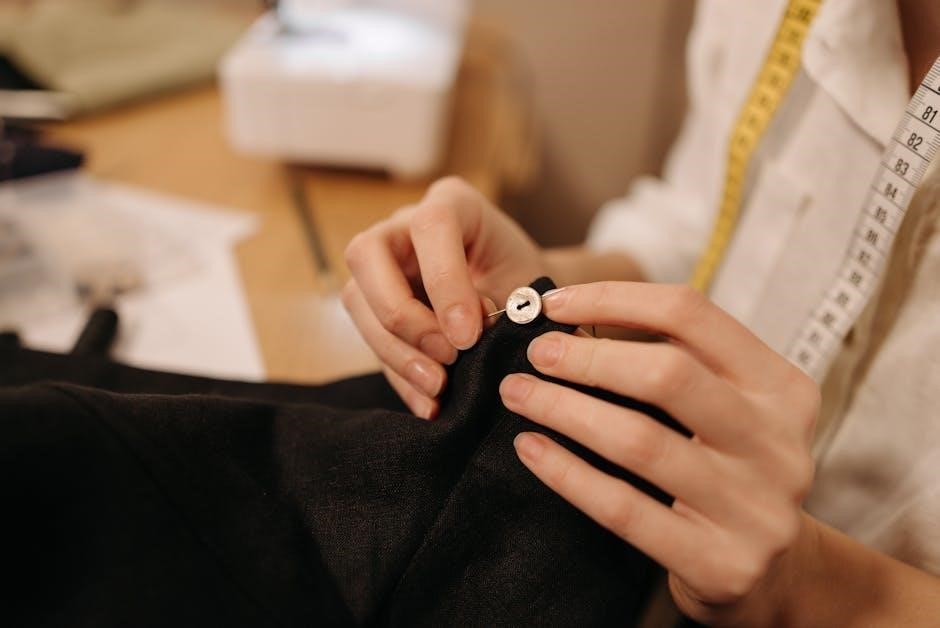
Basic Operations of the Singer 15-91
The Singer 15-91 is easy to operate, with straightforward threading, needle selection, and preparation steps for sewing various fabrics efficiently and consistently.
4.1 Threading the Machine (Upper and Bobbin Thread)
Threading the Singer 15-91 involves carefully guiding the upper thread through the tension discs and take-up lever, then through the needle. For the bobbin, insert the thread into the bobbin case, leaving about three inches free. Ensure the bobbin is correctly seated and the thread is pulled gently to secure it. Proper threading is essential for smooth stitching and to prevent thread breakage. Always refer to the manual for precise steps to avoid tangles or machine malfunction. Regular checks ensure consistent stitch quality and optimal performance of the sewing machine.
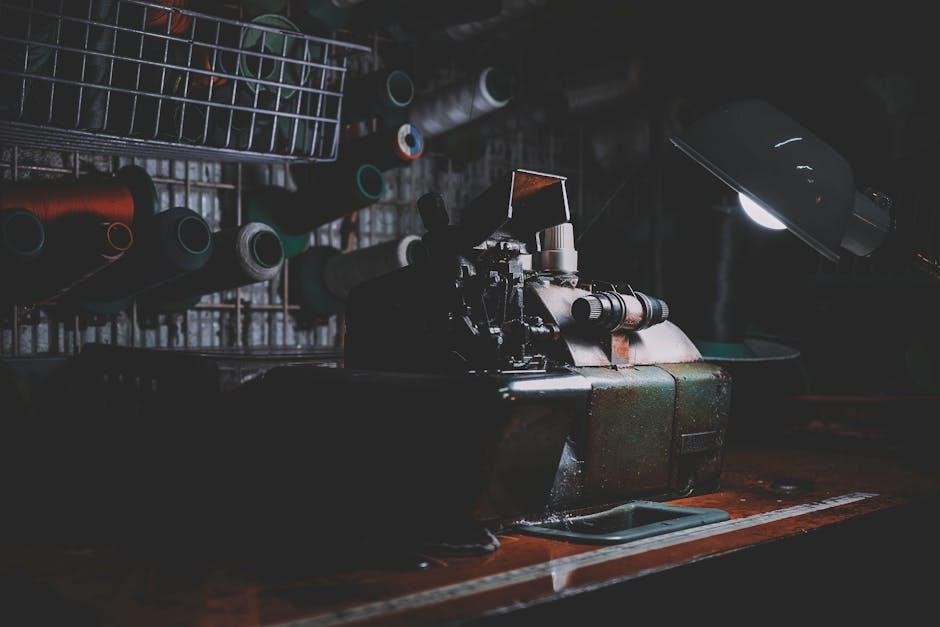
4.2 Selecting the Right Needle and Thread for Fabric
Selecting the right needle and thread is crucial for optimal performance. The Singer 15-91 uses standard sewing machine needles, with sizes varying based on fabric type. Heavier fabrics like denim require larger needles, while lighter fabrics like silk need smaller ones. Thread choice should match fabric weight and fiber content. Cotton thread is ideal for general use, while polyester suits stretchy or durable fabrics. Always ensure thread and needle compatibility to avoid breakage and ensure strong seams. Refer to the manual for specific recommendations. Using high-quality thread prevents tangles and ensures consistent stitching. Proper thread and needle selection enhances fabric compatibility and machine efficiency.
4.3 Preparing the Machine for Sewing
Before sewing, ensure the machine is clean and well-lubricated. Turn it on briefly to check for unusual noises. Attach the correct presser foot for your fabric type. Insert a compatible needle and ensure the bobbin is properly seated. Thread the machine as instructed, leaving about three inches of thread loose. Test the stitch quality on scrap fabric. Adjust tension if necessary. Ensure the power source is stable, using the recommended 110-120 volts. Keep the work area clear and maintain proper lighting. Following these steps ensures smooth operation and optimal stitching. Always refer to the manual for specific settings and adjustments. Proper preparation enhances sewing efficiency and reduces errors. Regular checks prevent mechanical issues and ensure consistent results. A well-prepared machine guarantees professional-quality stitching every time. Always test settings before starting your project. This ensures fabric compatibility and prevents thread breakage. Stay organized to maintain workflow efficiency.

Maintenance and Lubrication
Regular maintenance ensures the Singer 15-91 operates smoothly. Lubricate moving parts with Singer Sewing Machine Oil to prevent friction. Clean the machine and replace worn parts promptly.
5.1 Importance of Regular Lubrication
Regular lubrication is crucial for the Singer 15-91 to ensure smooth operation and prevent mechanical friction. Using Singer Sewing Machine Oil, apply a few drops to moving parts like the shuttle hook and gears. This prevents rust and wear, maintaining stitch quality and machine longevity. A dry machine can bind, leading to poor performance or damage. Lubrication should be part of routine maintenance, ideally after every 10 hours of use or when the machine feels sluggish. Always use the recommended oil to avoid damaging the internal components and keep the machine running efficiently for years. Proper lubrication is key to extending the machine’s lifespan and ensuring consistent stitching.
5.2 Using Singer Sewing Machine Oil
Using Singer Sewing Machine Oil is essential for maintaining the 15-91’s performance. Apply a few drops to the shuttle hook, gears, and other moving parts to reduce friction and prevent rust. Avoid using household oils, as they may damage components. Regular application ensures smooth operation and extends the machine’s lifespan. For optimal results, lubricate after every 10 hours of use or when the machine feels sluggish. Always refer to the manual for specific guidance on oil application points and quantities. Proper lubrication with Singer oil keeps the machine running efficiently and maintains consistent stitch quality. It is crucial for preserving the machine’s longevity and functionality.
5.3 Cleaning the Machine and Removing Lint
Cleaning the Singer 15-91 sewing machine and removing lint are crucial for maintaining its performance. Regularly inspect and clean the bobbin case, feed dogs, and shuttle hook to prevent lint buildup. Use a small brush or compressed air to gently remove debris. Avoid using liquids or harsh chemicals, as they may damage the machine. After cleaning, lubricate the moving parts with Singer Sewing Machine Oil to ensure smooth operation. Failure to clean regularly can lead to poor stitch quality, mechanical issues, or even damage to the motor. Always unplug the machine before cleaning and refer to the manual for specific guidance. Regular maintenance ensures optimal functionality and extends the machine’s lifespan.
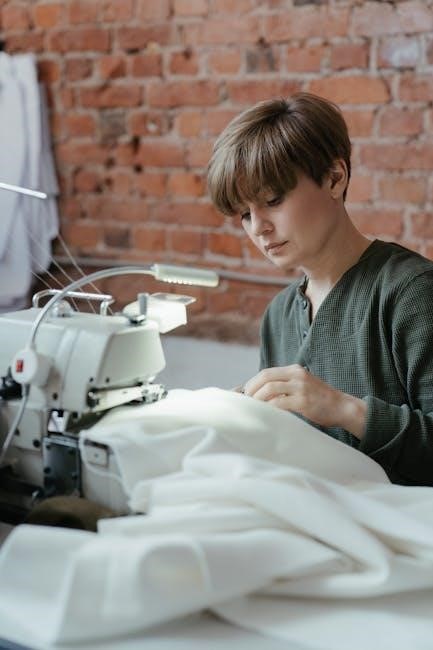
Troubleshooting Common Issues
This section addresses frequent problems like the machine not turning on, poor stitch quality, or excessive noise, providing solutions to restore smooth operation quickly and effectively.
6.1 Machine Not Turning On
If the Singer 15-91 sewing machine fails to turn on, first check the power source. Ensure the machine is properly plugged into a 110-120 volts AC/DC outlet. Verify that the power cord is not damaged. Check the circuit breaker or fuse box to ensure the outlet is functioning. If using an extension cord, confirm it is working correctly. Next, inspect the on/off switch for any visible damage or wear. Consult the user manual for additional troubleshooting steps, such as resetting the machine or checking for internal electrical issues. If the problem persists, contact an authorized Singer service center for professional assistance.
6.2 Poor Stitch Quality or Thread Breakage
Poor stitch quality or thread breakage on the Singer 15-91 can result from incorrect threading, improper tension settings, or using the wrong needle type. Ensure the upper and bobbin threads are correctly aligned and not tangled. Check the tension dials and adjust them according to the fabric type. A blunt or damaged needle can also cause issues, so replace it if necessary. Verify that the bobbin is properly seated and that the thread is evenly wound. If the problem persists, consult the user manual for guidance on adjusting the machine’s settings or lubricating parts. For severe issues, contact an authorized Singer service center for professional repair.
6.3 Excessive Noise or Vibration
Excessive noise or vibration in the Singer 15-91 may indicate improper lubrication or mechanical misalignment. Regularly clean the machine and remove lint buildup, especially around the bobbin and shuttle areas; Ensure all parts are properly aligned and securely fastened. Apply Singer Sewing Machine Oil to moving components as specified in the manual. If the noise persists, check for worn or damaged parts that may need replacement. A poorly seated shuttle or incorrect needle installation can also cause vibration. For persistent issues, consult the service manual or contact an authorized Singer repair center for professional assistance to restore smooth operation.
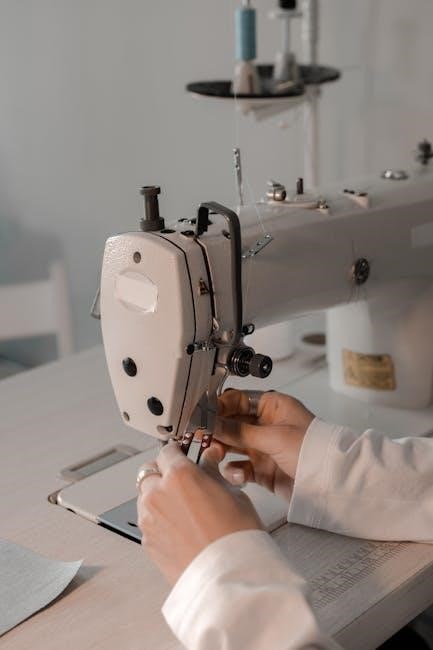
Singer 15-91 Manual Downloads
The Singer 15-91 manual is available as a free PDF download, offering detailed instructions for operation, maintenance, and troubleshooting. It includes user, adjuster, and service manuals.
7.1 User Manual (PDF Format)
The Singer 15-91 User Manual is available in PDF format, providing comprehensive guidance for operating, maintaining, and troubleshooting the sewing machine. It covers essential topics such as threading, selecting the right needles, and preparing the machine for sewing. The manual also includes detailed diagrams and step-by-step instructions to help users optimize their sewing experience. Download the free PDF from Singer’s official website or trusted sources like sewing communities and forums. Ensure you have an Adobe PDF reader installed to access the document. This manual is a valuable resource for both beginners and experienced users, offering clear instructions to ensure proper usage and care of the Singer 15-91 sewing machine.
7.2 Adjusters Manual for Advanced Users
The Adjusters Manual for the Singer 15-91 is designed for advanced users seeking detailed technical specifications and fine-tuning guidance. This manual provides in-depth instructions for adjusting the machine’s mechanisms, such as the shuttle, feed, and tension, to optimize performance. It also includes troubleshooting strategies for specific issues that may arise during use. Available in PDF format, the Adjusters Manual is ideal for users who want to customize their sewing experience or repair and maintain the machine themselves. It can be downloaded from Singer’s official website or trusted sources, ensuring users have access to authentic and detailed information. This resource is perfect for enthusiasts and professionals looking to maximize their machine’s potential.
7.3 Service Manual for Repair and Maintenance
The Singer 15-91 Service Manual offers comprehensive repair and maintenance instructions for technicians and skilled users. It covers disassembly, part replacement, and lubrication procedures. The manual includes detailed diagrams and step-by-step guides to ensure proper servicing. Available as a free PDF download, it helps maintain the machine’s durability and functionality. Regular use of Singer Sewing Machine Oil and cleaning are emphasized to prevent wear. This manual is essential for resolving complex issues and extending the machine’s lifespan. Users can download it from Singer’s official website or trusted sources, ensuring they have the correct tools and techniques for repairs and maintenance.
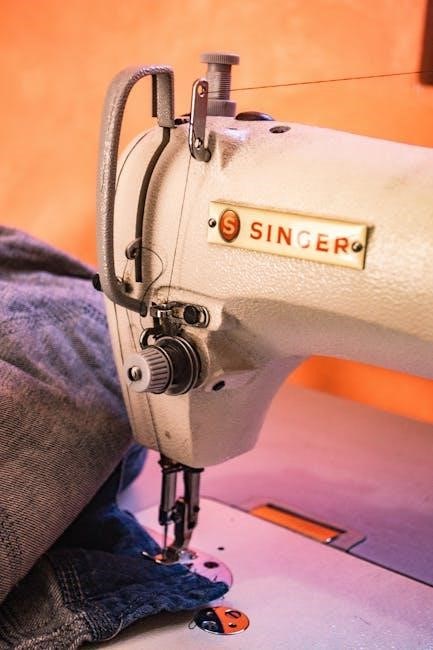
Additional Resources
Explore online communities, forums, and video tutorials for Singer 15-91 support. Authorized Singer service centers provide professional assistance for repairs and maintenance, ensuring optimal performance.
8.1 Online Communities and Forums
Online communities and forums dedicated to the Singer 15-91 sewing machine offer invaluable resources and support. Platforms like Singer’s official forums, Facebook groups, and Reddit communities provide spaces for users to share tips, troubleshoot issues, and discuss their experiences. These forums often feature detailed discussions about the Singer 15-91 manual, including step-by-step guides and advice from experienced sewists. Additionally, many communities share downloadable resources, such as PDF manuals, parts lists, and repair guides, making them essential for owners seeking to maintain or restore their machines. Engaging with these communities can enhance your understanding of the Singer 15-91 and help you maximize its potential for sewing projects.
8.2 Video Tutorials and Guides
Video tutorials and guides provide visual instruction for the Singer 15-91 sewing machine, covering topics like threading, maintenance, and troubleshooting. Platforms such as YouTube offer a wealth of content, including step-by-step demonstrations of manual instructions. Many videos focus on specific features, such as the oscillating shuttle and reversible feed mechanism, helping users understand and utilize their machine effectively. Additionally, some tutorials address common issues like poor stitch quality or excessive noise, offering practical solutions. These resources are particularly useful for visual learners and those who prefer hands-on guidance. By following these videos, users can enhance their sewing skills and ensure optimal performance of their Singer 15-91 machine.
8.3 Authorized Singer Service Centers
Authorized Singer service centers offer expert repair, maintenance, and genuine parts for the Singer 15-91 sewing machine. These centers are equipped with skilled technicians who understand the machine’s unique features, such as its oscillating shuttle and reversible feed mechanism. Users can trust these centers for professional servicing, ensuring their machine operates at peak performance. To locate an authorized service center, Singer provides an online directory on their official website. Regular maintenance at these centers can prevent issues like excessive noise or thread breakage. Additionally, they offer authentic Singer sewing machine oil and parts, ensuring compatibility and longevity. For any complex repairs or adjustments, visiting an authorized Singer service center is highly recommended. This ensures your machine remains in optimal condition for years of reliable use.

